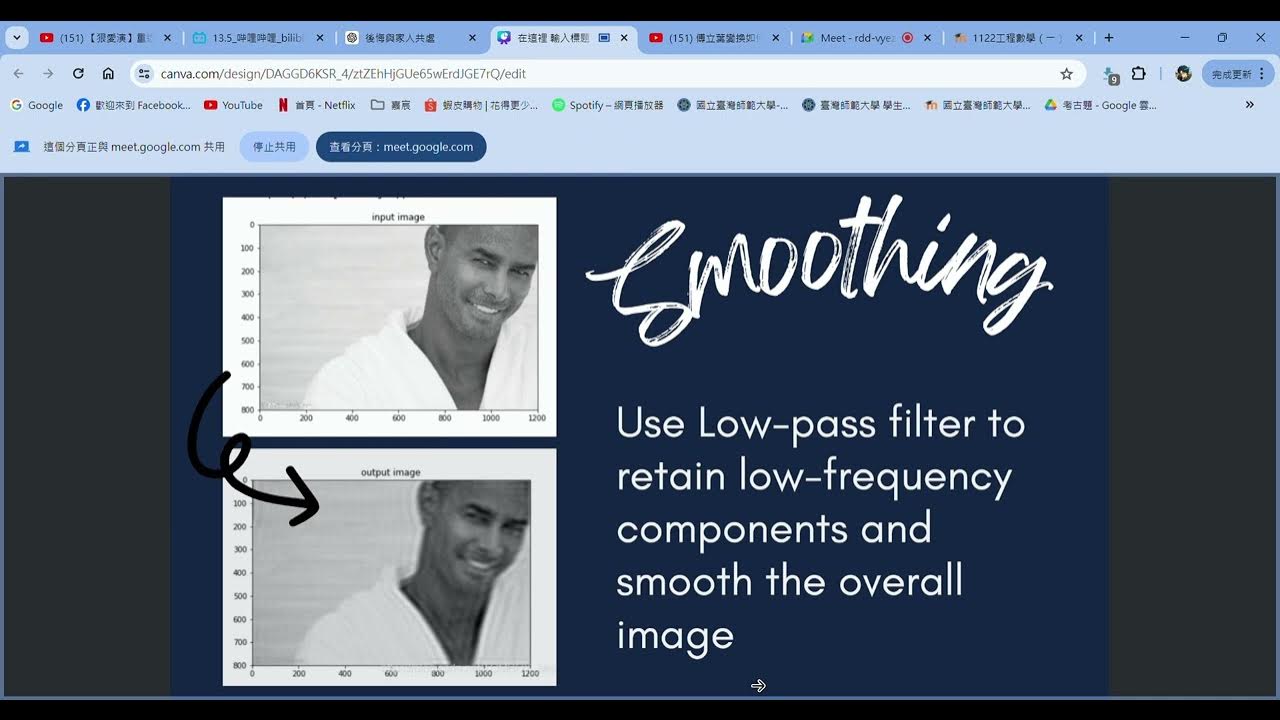工程數學(一)期末報告 Group 5
Summary
TLDRThis presentation delves into the realm of image filtering using Fourier series and Fourier transform. It begins with an introduction to time and frequency domains, explaining how frequency analysis can simplify signal processing. The script covers continuous and discrete Fourier transforms, highlighting their applications in image processing, such as reducing computational load in convolution through frequency domain multiplication. It also demonstrates the implementation of image filtering, particularly high-pass filtering, to enhance image edges, showcasing the practical utility of Fourier transforms in digital signal processing.
Takeaways
- 📚 The presentation introduces the concept of image filtering using Fourier series and Fourier transform, starting with the basics of time and frequency domains.
- 🔍 It explains how the time domain represents sound signals with amplitude over time, while the frequency domain shows the frequency components of those signals.
- 👦👧 The script uses the example of male and female voices to illustrate the differences in frequency components, with males having more low-frequency components and females having more high-frequency components.
- 🔧 The purpose of frequency analysis is to convert difficult-to-process time domain information into more analyzable frequency domain information.
- 🔄 The script covers both one-dimensional and two-dimensional signals, explaining how periodic signals in two variables can be represented using Fourier series.
- 🌐 The Fourier transform is introduced as a method to decompose a one-dimensional signal into complex exponential waves, which can be visualized as a combination of cosine and sine waves.
- 📊 The frequency domain is characterized by coordinates representing frequency and amplitude, with the absolute value of the complex number indicating amplitude and the angle representing phase.
- 📈 The presentation moves on to continuous time Fourier transform and discrete time Fourier transform, explaining their formulas and properties.
- 🛠️ It discusses the practical applications of Fourier transform in image processing, particularly in reducing computational resources needed for convolution through the use of frequency domain multiplication.
- 🖼️ The script details the process of implementing an image highpass filter using the Fourier transform, which enhances the edges of an image and aids in feature detection.
- 📉 The results of applying a highpass filter are demonstrated, showing a reduction in low-frequency components and an enhancement of high-frequency signals, indicating successful filtering.
Q & A
What is the main topic of the presentation?
-The main topic of the presentation is image filtering using Fourier series and Fourier transform.
What are the two domains introduced at the beginning of the presentation?
-The two domains introduced are the time domain and the frequency domain.
How do the male and female voices differ in terms of frequency components according to the script?
-The male voice has relatively large low-frequency components, while the female voice has richer high-frequency components.
What is the purpose of converting the time domain signal into the frequency domain?
-The purpose is to locate the signal flow within a specific time range and identify its content and meaning, making it easier to analyze.
What is the difference between Fourier series and Fourier transform in terms of the signals they deal with?
-Fourier series deals with periodic and continuous signals, while Fourier transform deals with non-periodic signals.
What are the three parameters needed to determine a sine wave in the frequency domain?
-The three parameters are frequency, amplitude, and phase.
What is the significance of the formula for the continuous time Fourier transform?
-The formula is used to synthesize signals that are not periodic, using all frequencies to determine the weight of the exponential components.
Why is the discrete Fourier transform (DFT) used instead of the continuous time Fourier transform for digital systems?
-DFT is used because digital systems work with discrete time signals, which are constructed from discrete complex exponentials.
What is the main advantage of using Fourier transform in image processing over convolution?
-Using Fourier transform reduces the computational resources needed for image processing by allowing direct multiplication in the frequency domain instead of convolution in the spatial domain.
How does a high-pass filter affect the appearance of an image?
-A high-pass filter enhances the edges of the image, which can be useful for edge detection.
What is the final step in the image processing procedure using Fourier transform mentioned in the script?
-The final step is performing an inverse Fourier transform on the result to obtain the final output image after applying the filter.
Outlines

This section is available to paid users only. Please upgrade to access this part.
Upgrade NowMindmap

This section is available to paid users only. Please upgrade to access this part.
Upgrade NowKeywords

This section is available to paid users only. Please upgrade to access this part.
Upgrade NowHighlights

This section is available to paid users only. Please upgrade to access this part.
Upgrade NowTranscripts

This section is available to paid users only. Please upgrade to access this part.
Upgrade Now5.0 / 5 (0 votes)





